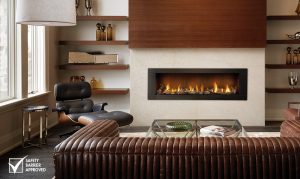Are you thinking of switching your heating system over to a wood-burning fireplace or wood stove? When comparing wood-burning applications to heating systems that run on gas or electricity, you’ll want to consider the benefits and drawbacks of both. At 2nd Generation Chimneys, we clean, repair, and inspect traditional fireplaces, wood stoves, pellet stoves, and gas log fireplace inserts. We’ve put together some factors to consider if you are thinking that you might like to install a new fireplace or stove.
Fireplaces
In addition to the aesthetics of a warm fire, a fireplace can be a great source of heat if you are heating a small home. Depending on the price of wood, a traditional fireplace can be an inexpensive way to heat a given area within the home. If you want to install a gas log insert, then you’ll need to factor in the cost of the extra gas piping. Any type of fireplace should be inspected every year according to the CSIA (Chimney Safety Institute of America) standards, so this is also something to keep in mind.
In addition to routine chimney cleanings and inspections, you will also have to think about storage space for wood, and the effort involved in starting a fire every day during the winter. Wood needs to be stored in a dry area, and you should only burn seasoned wood, which means that the wood has been completely dried out for at least six months. Other factors include clearance for the chimney, the square footage of the area that you need to heat, and how well your home is insulated. There will be some heat loss due to the use of a chimney, but if your damper, chimney cap, and masonry are all in good condition, there will be less air loss and better efficiency.
Wood Stoves and Pellet Stoves
Wood stoves are a little more efficient than an open fireplace, and depending on the type and model you choose, you can get up to 50,000 BTUs with some wood stoves. There are many different designs, and they can be installed as a freestanding wood stove or inserted into an existing fireplace (depending on height and condition of the chimney flue).
If you are considering a switching to pellet fuel, keep in mind that there are many different heating applications that use pellets. Freestanding pellet stoves are the most common type, and wood pellets are a highly efficient and renewable fuel. In addition, pellet stoves are relatively effortless since they only need to be refueled about once a day. However, there’s more maintenance a regular wood-burning application due to the moving parts in the feeding arm.
Call the St Paul fireplace and chimney experts at 2nd Generation if you would like to learn more.
Continue Reading
Tags: Fireplaces, Heating, Maple Grove, Minneapolis, St. Paul
Posted in Heating | Comments Off on St Paul Heating FAQ: How Do Wood-Burning Fireplaces and Stoves Compare to Other Types of Heating Systems?

